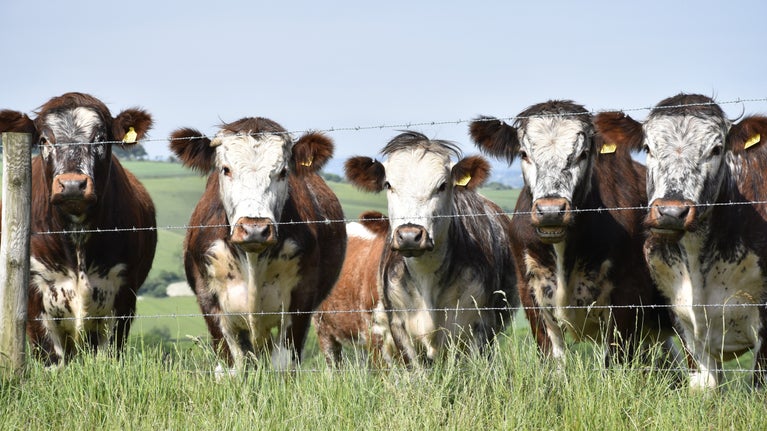
Discover more at Ludshott Common
Find out how to get to Ludshott Common, where to park, the things to see and do and more.

The heathland habitats of Ludshott Common are recognised as internationally important for wildlife, including insects, reptiles and ground-nesting birds. Find out more about the work we do in partnership with Natural England and the South Downs National Park to maintain and restore them, including by bringing back the tradition of grazing cattle here.
Heathlands are open spaces with acidic soils, home to low-growing plants like heather, gorse and grasses. They provide a mosaic of different habitats, supporting a wide range of wildlife species, many of which would struggle to survive anywhere else.
Although many heathlands in the UK were created by prehistoric farmers to make space for grazing animals, the conditions they provide have been around for much longer and are ideal for the plants that grow there and the wildlife they support.
If we don't preserve heathlands, many of these species will be in danger of disappearing forever.
Ludshott Common is recognised as internationally important for its wildlife. It's a designated Site of Special Scientific Interest SSSI) and a Special Protection Area (SPA).
The heathland is home to a wide variety of endangered, declining and protected species including the rare grayling and silver-studded blue butterflies, and reptiles such as the sand lizard, adder and grass snake. It's also a particularly important habitat for ground-nesting birds like the Dartford warbler, nightjar and woodlark.
Ludshott Common is now part of the Wealden Heaths National Nature Reserve – one of the King's Series of National Nature Reserves – covering 2,766 hectares across Hampshire, Surrey and West Sussex.

Conservation grazing uses small numbers of specially chosen livestock to manage the growth of scrub, and grasses in open areas like heathland.
This allows a much more varied mix of plants to grow, maintaining a wider range of habitats that support a greater diversity of wildlife.
The dung produced by the livestock, and the way their hooves break up the ground as they graze, have added benefits for creating and maintaining these habitats.
Livestock were grazed on the landscape that now includes Ludshott Common for centuries but as intensive farming took over, the practice died out.
Since grazing ended on Ludshott Common, scrub, grasses, bracken and trees have gradually threatened to overtake the heathland, endangering the rare mix of important wildlife habitats that exist here.
That's why, from October 2025, cattle will once again be seen grazing on Ludshott Common, working alongside our ongoing cutting of overgrowth to restore and maintain the heathland, its habitats and the wildlife they support.
These two approaches are most effective when used in tandem: cutting back the growth opens up inaccessible heathland, while grazing reduces the rate of regrowth.
The cattle grazing Ludshott Common are 14-month-old pedigree British Shorthorn steers (castrated males). They are particularly well-suited to the less intensive farming of a heathland grazing environment.
The way these native cattle graze, and the different plants they eat, will best manage regrowth of scrub and will lead to a mix of plants that provides the most varied and most appropriate range of habitats on the common.
The cattle will graze Ludshott Common for 9 months of the year, September to May, spending all their time there, including overnight.

Working with Natural England, a government organisation that monitors and funds habitat management for nature and public access, we carry out annual scrub clearance and forestry work to manage and restore the heathland at Ludshott Common.
We use a variety of techniques to do this, designed to replicate the rural activities that traditionally kept the heathland open in the past. Along with conservation grazing, these include cutting scrub and gorse by hand, forestry work, bracken control, foraging heather and creating bare ground by scraping.
These different approaches help to maintain the complex mosaic of heathland habitats that supports so many different species.
The majority of our heathland management work takes place from September to March to avoid ground-nesting bird season.
The methods used to restore and manage heathland can sometimes look quite dramatic, and seemingly at odds with the current emphasis on planting trees for environmental reasons.
But although trees are important for capturing and storing carbon from the air, the natural processes that take place on open heathland are actually far more effective at doing this.
Nevertheless, large areas of the common will remain as woodland, managed as they have been for hundreds of years, to maintain important wildlife habitats alongside those provided by the heathland.
Together this will offer the widest range of different habitats and eco-systems possible, supporting the greatest variety of wildlife.
Ludshott Common is an area of archaeological as well as scientific significance, used as an army camp and training base during both world wars.
We work closely with the Liss Archaeological Society to mark out sites of historical interest and make sure they are protected.

Find out how to get to Ludshott Common, where to park, the things to see and do and more.

Natural England is the government’s adviser for the natural environment in England. They help to protect and restore our natural world.
The heathland at Ludshott Common dates back 5,000 years and contains some of the few remaining areas of lowland heath in Europe. Discover some of the birdlife and wildlife you can see here, as well as similar heathlands and woodlands you can visit nearby.

Everything you need to know to ensure you have a safe and enjoyable visit with your dog, including which times of year the law says they must be kept on a lead.

We believe that nature, beauty and history are for everyone. That’s why we’re supporting wildlife, protecting historic sites and more. Find out about our work.
